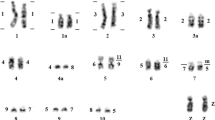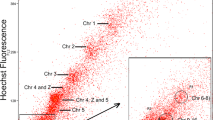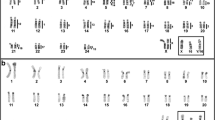Abstract
Fluorescence in situ hybridization (FISH), especially chromosome painting, has been extensively exploited in the phylogenetic reconstruction of primate evolution. Although chromosome painting is a key method to map translocations, it is not effective in detecting chromosome inversions, which may be up to four times more frequent than other chromosomal rearrangements. BAC-FISH instead can economically delineate marker order and reveal intrachromosomal rearrangements. However, up to now, BAC-FISH was rarely used to study the chromosomes of New World monkeys partly due to technical difficulties. In this paper, we used BAC-FISH to disentangle the complex evolutionary history of the ancestral 14/15 association in NWMs, beginning from the squirrel monkey (Saimiri boliviensis). To improve the hybridization efficiency of BAC-FISH in NWMs, we “translated” the human BACs into Callithrix jacchus (CJA) BACs, which yielded much higher hybridization efficiencies on other NWM species than human BACs. Our results disclosed 14 synteny blocks in squirrel monkeys, 7 more than with chromosome painting. We then applied a subset of CJA BACs on six other NWM species. The comparison of the hybridization pattern of these species contained phylogenetic information to discriminate evolutionary relationships. Notably Aotus was found to share an inversion with Callithrix, thus definitely assigning the genus Aotus to Cebidae. The present study can be seen as a paradigmatic approach to investigate the phylogenetics of NWMs by molecular cytogenetics.




Similar content being viewed by others
References
Amaral PJS, Finotelo LFM, De Oliveira EHC, Pissinatti A, Nagamachi CY, Pieczarka JC (2008) Phylogenetic studies of the genus Cebus (Cebidae-Primates) using chromosome painting and G-banding. BMC Evol Biol 8:169
Chatterjee HJ, Ho SY, Barnes I, Groves C (2009) Estimating the phylogeny and divergence times of primates using a supermatrix approach. BMC Evol Biol 9:259
Consigliere S, Stanyon R, Koehler U, Agoramoorthy G, Wienberg J (1996) Chromosome painting defines genomic rearrangements between red howler monkey subspecies. Chromosome Res 4:264–270
Consigliere S, Stanyon R, Koehler U, Arnold N, Wienberg J (1998) In situ hybridization (FISH) maps chromosomal homologies between Alouatta belzebul (Platyrrhini, Cebidae) and other primates and reveals extensive interchromosomal rearrangements between howler monkey genomes. Am J Primatol 46:119–133
Davis BW, Raudsepp T, Pearks Wilkerson AJ, Agarwala R, Schaffer AA, Houck M, Chowdhary BP, Murphy WJ (2009) A high-resolution cat radiation hybrid and integrated FISH map** resource for phylogenomic studies across Felidae. Genomics 93:299–304
de Oliveira EH, Neusser M, Muller S (2012) Chromosome evolution in new world monkeys (Platyrrhini). Cytogenet Genome Res 137:259–272
Dumas F, Bigoni F, Stone G, Sineo L, Stanyon R (2005) Map** genomic rearrangements in titi monkeys by chromosome flow sorting and multidirectional in-situ hybridization. Chromosome Res 13:85–96
Dumas F, Stanyon R, Sineo L, Stone G, Bigoni F (2007) Phylogenomics of species from four genera of New World monkeys by flow sorting and reciprocal chromosome painting. BMC Evol Biol 7(Suppl 2):S11
Faraut T (2008) Addressing chromosome evolution in the whole-genome sequence era. Chromosome Res 16:5–16
Garcia F, Nogues C, Ponsa M, Ruiz-Herrera A, Egozcue J, Garcia Caldes M (2000) Chromosomal homologies between humans and Cebus apella (Primates) revealed by ZOO-FISH. Mamm Genome 11:399–401
Garcia F, Ruiz-Herrera A, Egozcue J, Ponsa M, Garcia M (2002) Chromosomal homologies between Cebus and Ateles (primates) based on ZOO-FISH and G-banding comparisons. Am J Primatol 57:177–188
Giannuzzi G, Pazienza M, Huddleston J, Antonacci F, Malig M, Vives L, Eichler EE, Ventura M (2013) Hominoid fission of chromosome 14/15 and the role of segmental duplications. Genome Res 23:1763–1773
Gifalli-Iughetti C, Koiffmann CP (2009) Synteny of human chromosomes 14 and 15 in the platyrrhines (Primates, Platyrrhini). Genet Mol Biol 32:786–791
Graphodatsky A, Ferguson-Smith MA, Stanyon R (2012) A short introduction to cytogenetic studies in mammals with reference to the present volume. Cytogenet Genome Res 137:83–96
Groves CP (2005) Order Primates. Johns Hopkins University Press
Jameson Kiesling NM, Yi SV, Xu K, Gianluca Sperone F, Wildman DE (2015) The tempo and mode of New World monkey evolution and biogeography in the context of phylogenomic analysis. Mol Phylogenet Evol 82:386–399
Jauch A, Wienberg J, Stanyon R, Arnold N, Tofanelli S, Ishida T, Cremer T (1992) Reconstruction of genomic rearrangements in great apes and gibbons by chromosome painting. Proc Natl Acad Sci U S A 89:8611–8615
Morescalchi MA, Schempp W, Consigliere S, Bigoni F, Wienberg J, Stanyon R (1997) Map** chromosomal homology between humans and the black-handed spider. Chromosome Res 5:527–536
Muller S, Stanyon R, O'Brien PC, Ferguson-Smith MA, Plesker R, Wienberg J (1999) Defining the ancestral karyotype of all primates by multidirectional chromosome painting between tree shrews, lemurs and humans. Chromosoma 108:393–400
Murphy WJ, Larkin DM, Everts-van der Wind A, Bourque G, Tesler G, Auvil L, Beever JE, Chowdhary BP, Galibert F, Gatzke L, Hitte C, Meyers SN, Milan D, Ostrander EA, Pape G, Parker HG, Raudsepp T, Rogatcheva MB, Schook LB, Skow LC, Welge M, Womack JE, O'Brien SJ, Pevzner PA, Lewin HA (2005) Dynamics of mammalian chromosome evolution inferred from multispecies comparative maps. Science 309:613–617
Neusser M, Stanyon R, Bigoni F, Wienberg J, Muller S (2001) Molecular cytotaxonomy of New World monkeys (Platyrrhini)—comparative analysis of five species by multi-color chromosome painting gives evidence for a classification of Callimico goeldii within the family of Callitrichidae. Cytogenet Cell Genet 94:206–215
Nie W, O'Brien PC, Fu B, Wang J, Su W, Ferguson-Smith MA, Robinson TJ, Yang F (2005) Chromosome painting between human and lorisiform prosimians: evidence for the HSA 7/16 synteny in the primate ancestral karyotype. Am J Phys Anthropol 129:250–259
Osterholz M, Walter L, Roos C (2009) Retropositional events consolidate the branching order among New World monkey genera. Mol Phylogenet Evol 50:507–513
Perelman P, Johnson WE, Roos C, Seuánez HN, Horvath JE, Moreira MAM, Kessing B, Pontius J, Roelke M, Rumpler Y, Schneider MPC, Silva A, O'Brien SJ, Pecon-Slattery J (2011) A molecular phylogeny of living primates. PLoS Genet 7:e1001342
Perez SI, Klaczko J, dos Reis SF (2012) Species tree estimation for a deep phylogenetic divergence in the New World monkeys (Primates: Platyrrhini). Mol Phylogenet Evol 65:621–630
Purgato S, Belloni E, Piras FM, Zoli M, Badiale C, Cerutti F, Mazzagatti A, Perini G, Della Valle G, Nergadze SG, Sullivan KF, Raimondi E, Rocchi M, Giulotto E (2015) Centromere sliding on a mammalian chromosome. Chromosoma 124:277–287
Purvis A (1995) A composite estimate of primate phylogeny. Philos Trans R Soc Lond B Biol Sci 348:405–421
Ray DA, **ng J, Hedges DJ, Hall MA, Laborde ME, Anders BA, White BR, Stoilova N, Fowlkes JD, Landry KE, Chemnick LG, Ryder OA, Batzer MA (2005) Alu insertion loci and platyrrhine primate phylogeny. Mol Phylogenet Evol 35:117–126
Rocchi M, Archidiacono N, Schempp W, Capozzi O, Stanyon R (2012) Centromere repositioning in mammals. Heredity 108:59–67
Ruiz-Herrera A, Farre M, Robinson TJ (2012) Molecular cytogenetic and genomic insights into chromosomal evolution. Heredity (Edinb) 108:28–36
Rylands AB, Mittermeier RA (2014) Primate taxonomy: species and conservation. Evol Anthropol 23:8–10
Springer MS, Meredith RW, Gatesy J, Emerling CA, Park J, Rabosky DL, Stadler T, Steiner C, Ryder OA, Janecka JE, Fisher CA, Murphy WJ (2012) Macroevolutionary dynamics and historical biogeography of primate diversification inferred from a species supermatrix. PLoS ONE 7:e49521
Stanyon R, Consigliere S, Muller S, Morescalchi A, Neusser M, Wienberg J (2000) Fluorescence in situ hybridization (FISH) maps chromosomal homologies between the dusky titi and squirrel monkey. Am J Primatol 50:95–107
Stanyon R, Bonvicino CR, Svartman M, Seuanez HN (2003) Chromosome painting in Callicebus lugens, the species with the lowest diploid number (2 n = 16) known in primates. Chromosoma 112:201–206
Stanyon R, Bigoni F, Slaby T, Muller S, Stone G, Bonvicino CR, Neusser M, Seuanez HN (2004) Multi-directional chromosome painting maps homologies between species belonging to three genera of New World monkeys and humans. Chromosoma 113:305–315
Stanyon R, Rocchi M, Capozzi O, Roberto R, Misceo D, Ventura M, Cardone M, Bigoni F, Archidiacono N (2008) Primate chromosome evolution: ancestral karyotypes, marker order and neocentromeres. Chromosome Res 16:17–39
Stanyon R, Garofalo F, Steinberg ER, Capozzi O, Di Marco S, Nieves M, Archidiacono N, Mudry MD (2011) Chromosome painting in two genera of South American monkeys: species identification, conservation, and management. Cytogenet Genome Res 134:40–50
Stanyon R, Rocchi M, Bigoni F, Archidiacono N (2012) Evolutionary molecular cytogenetics of catarrhine primates: past, present and future. Cytogenet Genome Res 137:273–284
Ventura M, Mudge JM, Palumbo V, Burn S, Blennow E, Pierluigi M, Giorda R, Zuffardi O, Archidiacono N, Jackson MS, Rocchi M (2003) Neocentromeres in 15q24-26 map to duplicons which flanked an ancestral centromere in 15q25. Genome Res 13:2059–2068
Wienberg J, Stanyon R, Jauch A, Cremer T (1992) Homologies in human and Macaca fuscata chromosomes revealed by in situ suppression hybridization with human chromosome specific libraries. Chromosoma 101:265–270
Worley KC, Warren WC, Rogers J, Locke D, Muzny DM et al (2014) The common marmoset genome provides insight into primate biology and evolution. Nat Genet 46:850–857
Acknowledgments
“PRIN 2012” funding from Ministero dell'Istruzione dell'Università e della Ricerca is acknowledged.
Author information
Authors and Affiliations
Corresponding authors
Ethics declarations
International, national, and institutional guidelines for the care and use of animals were followed.
Conflict of interest
The authors declare that they have no competing interests.
Electronic supplementary material
Below is the link to the electronic supplementary material.
Fig. 1
Co-hybridization experiment on Saimiri boliviensis preparation of painting probes specific for human chromosome 14 (green) and 15 (red). The FISH signal are on SBO chromosomes 2 and 7. The arrow indicate the 15B fragment of human chromosome 15 on SBO7. (JPG 303 kb)
Supplemental Table 1
List of all genomic clones used in FISH experiments to characterize the synteny organization of the 14/15 association in 7 NWM species, specified in the first row, columns E-K (SBO = Saimiri boliviensis; CCP = Cebus capucinus; CAP = Cebus apella; ALE = Aotus lemurinus griseimembra; CJA = Callithrix jacchus; LLA = Lagothrix lagothrica; CMO = Callicebus moloch). The genomic clones are ordered according to their position (hg19) on the human chromosomes 15 (top) or 14 (bottom) (column D). Clones of the marmoset library CH259 are positioned also on the marmoset genome assembly CalJac3, as reported in UCSC database. For each clone is also reported its cytogenetic position (p or q arm, columns E-K). Yellow lines indicate a synteny breakage in that species, that can be species specific or shared with other species. Synteny breaks in Saimiri are numbered in column L. Synteny blocks generated by these breakpoints are numbered in column A in alphabetical order. (PDF 54 kb)
Supplemental Table 2
Synteny blocks organization on the q arm of Saimiri boliviensis chromosome 2. Clones of the marmoset library CH259 are positioned also on the marmoset genome assembly CalJac3, as reported in UCSC database. For each clone is also reported its cytogenetic position (p or q arm, column E). Yellow lines indicate a synteny breakage. Clones of the marmoset library CH259 are positioned also on the marmoset genome assembly CalJac3, as reported in UCSC database. (PDF 48 kb)
Supplemental Table 3-5
Each Table lists of genomic clones mapped on chromosome 8 of Aotus lemurinus (Supplemental Table 3), chromosome 6 of Cebus capucinus (Supplemental Table 4),and chromosome 6 of Cebus apella (Supplemental Table 5). Yellow lines indicate a synteny breakage. Clones of the marmoset library CH259 are positioned also on the marmoset genome assembly CalJac3, as reported in UCSC database (PDF 40 kb)
Supplemental Table 6
(PDF 32 kb)
Rights and permissions
About this article
Cite this article
Capozzi, O., Archidiacono, N., Lorusso, N. et al. The 14/15 association as a paradigmatic example of tracing karyotype evolution in New World monkeys. Chromosoma 125, 747–756 (2016). https://doi.org/10.1007/s00412-015-0565-2
Received:
Revised:
Accepted:
Published:
Issue Date:
DOI: https://doi.org/10.1007/s00412-015-0565-2




